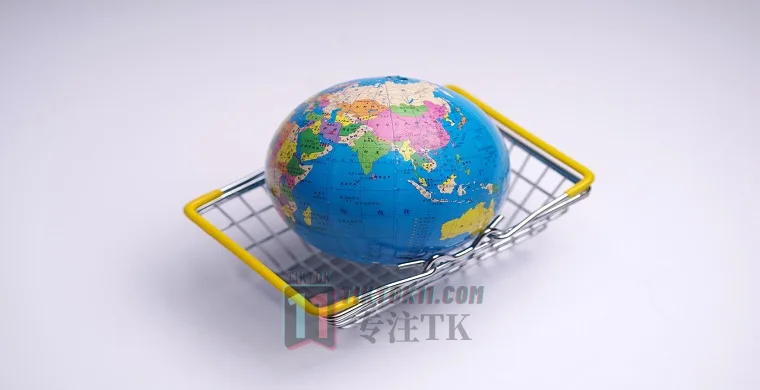The webmaster is ready to update some dry goods article topic to share with you, this is the first one, TikTok market analysis - how to choose the country market, this article will be very long, more than 7500 words, but dry goods full, the webmaster will give you to analyze the advantages and disadvantages of the TK's current several markets, so that you can accurately locate the article has not yet been accompanied by a picture, but it is all some of the experience.
I will explain two core elements. First, which market we need to choose for TK, and second, what the current TK live environment looks like.
How do you choose a market and understand the current market environment?
First of all, I think the market can be divided into four categories: Europe and the United States, Southeast Asia, Chinese and small language developed areas, such as Japan and South Korea, Italy, France, the Middle East, these are called small language developed areas.
Market selection is an important issue. My team and I have done a lot of markets, including Southeast Asia, Japan, Chinese market and European and American markets. Next, I will tell you how to choose the market.
The main markets in Southeast Asia include Singapore, Indonesia, Philippines, Vietnam, Thailand and Malaysia. The first thing you need to understand is that there are a lot of markets out there, but Little Yellow Bike isn't fully available in all of them, and some of them don't even have Little Yellow Bike at all. However, in Southeast Asia, most of the regions already have Little Yellow Bikes because of their own high e-commerce penetration.
Types of stores and small yellow bikes
There are two types of small yellow bikes, one is local small store small yellow bikes and the other is cross-border small yellow bikes. For example, in Indonesia, only small local stores have small yellow bikes, and there are no cross-border small yellow bikes.
A local store is a seller who has a business license in a certain country or region, and they can use that country's or region's business license to apply for a small yellow car. This threshold is relatively low, but for sellers from other countries or regions, they need to use their home country's business license to register, as domestic business licenses cannot be registered. Therefore.The Little Local Shop is a small yellow car designed for local sellersI hope you understand that.
The second type of store is called a cross-border store. A cross-border store is a store that is registered in another country or region using a Chinese business license. For example, if I want to enter the Indonesian market, can I register a store using a Chinese business license, if yes, then it is called a cross-border store. But unfortunately, in Indonesia, there are only local stores, no cross-border stores. So it is not possible to register store using mainland business license
Singapore, the Philippines, Thailand and Malaysia, and Vietnam all have cross-border and local operations, but Indonesia is currently the only Southeast Asian country without a cross-border presence. However, Indonesia itself has the largest e-commerce market, which can reach $8 million in daily transactions, larger than many other Southeast Asian regions. While the Philippines has a daily transaction volume of only $1 million to $2 million, and Thailand $2 million to $3 million, Indonesia reaches $8 million. As a result, Indonesia is currently the single largest e-commerce market in Southeast Asia.
Two core references
I have two core references as to whether the Southeast Asian market is the right place for us to go to.. First, you need to determine where to do it; second, you need to consider how much money you want to make.
Southeast Asia Market Analysis
If you are doing the Southeast Asian market domestically, then you won't stand a chance. This is because, with the exception of Singapore, the Southeast Asian market has very limited spending power and development capacity. Singapore's GDP per capita has reached about $70,000 per year, which is a very high level. But the situation is different in the other markets, they all have very low consumption power andlabor costIt's also very low.
For example, today I'm going into the Thai market, where thelabor costand GDP per capita are very low. Therefore, we can recruit staff at a very low cost. If I recruit anchors in Thailand itself, I only need to pay a base salary of 2,000 to 3,000 RMB. But if we want to recruit Thai-speaking anchors in Shenzhen, then the base salary has to be 15,000 RMB. And it's hard to find Thai-speaking talent because there are almost no Thai-speaking people in the country. Therefore, in this caseThe anchor'slabor costIt's very high, and there's a dearth of talent resources.
When recruiting anchors in China, the base salary may only be 2,000 or 3,000 RMB, while very good anchors can be recruited in Thailand itself. But if we offer a base salary of 15,000 RMB in China, it is even difficult to find an anchor who can speak Thai fluently. Therefore, we can recruit Thai-speaking anchors at five times the salary, while the other party can only recruit the same anchors at one-fifth the price, so that ourlabor costThat's five times as much as the other guy.
At this point in time, if we fight a price war, there is no advantage. And Southeast Asia itself is destined to fight a price war due to its lack of spending power. Therefore, it is difficult for us to cope becauselabor costIt's already too high.
Secondly, the Southeast Asian market itself is very fragmented. We go to Europe and the United States, and Europe and the United States is dominated by the United States, and we can do the U.S. market alone because the United States is the largest single market in the world. And China is the world's second largest single market. But Southeast Asia is not a single market, we need to clarify their positioning in the Southeast Asian market.
As the Southeast Asian markets are very different in terms of language and religion, for example, Thailand uses Thai language and believes in Buddhism, while the Philippines uses mainly English and has different religious beliefs. Therefore, it is not possible for you to operate in both markets in Southeast Asia, and even if you could, the costs would be significant.
Since Thailand and the Philippines play differently, they will face different problems. You are operating in a small market in a large area, but because of the lack of spending power in this small market, then unless you are operating in some large category such as women's clothing or women's bags, etc., you won't be able to make any money if you have a very small niche and the majority of Southeast Asian people have very little spending power.
Therefore.The first step in choosing a good market depends first and foremost on where you operate.If you're operating domestically.labor costToo high to have a chance, but there are opportunities locally. For example, if you want to enter the Thai market, you can go and operate locally in Thailand, which is feasible. But operating in the country is unrealistic because you don't have an anchor and it's very hard to find the right talent when the anchor's salary is very high.
Secondly, you need to be clear about your niche, i.e. how much money you want to make. If you want to make money in the Philippine market but want to make a lot of money, that is unrealistic. It is difficult to make a lot of money in the Philippines because the per capita spending power and the size of the market are relatively small. Therefore, you need to have a clear positioning for yourself. This is the overall environment of the Southeast Asian market. In the Southeast Asian market, the price war is very intense. For example, if I want to sell this plug-in board, and someone else sees that my gross margin is 40%, they might just lower the price to 20%.
He's not making money now, but his profits will come out after he squeezes out the competition. Or the same plug boards, they look exactly the same but use inferior plastics and electronics. To the user, there is no difference between our products. But since my gross margin is 50% and he is working with the factory on a 1:1 ratio to produce the same product. By reducing the cost, his gross margin can be 70%.
Southeast Asian marketsenvironment in which sth. is thrown into circulationIt is already mature and has a high return on investment. Therefore, it is very difficult to do the Southeast Asian market in China. If you have to enter this market, it is better to choose short video banding rather than live banding. Because short video banding can directly translate and add subtitles, you don't need to recruit anchors, and you won't encounter recruitment difficulties. However, if you want to do live streaming banding, anchors are the scarcest resource, which is not available in China. Therefore, if you want to succeed in the Southeast Asian market, it will be difficult unless you are in Singapore.
The Singapore market has a high spending power, but with a population of less than 6 million, it is smaller than Shanghai. Therefore, although it is possible to make money in Singapore, it is not realistic to try to do a very large business due to the small size of the market. Overall, the Singapore market can also be considered domestically.
Although the market volume is not large, but the small team can live a good life, two or three people can earn hundreds of thousands of dollars or even two or three hundred thousand dollars in profit a month. In other markets, Indonesia, the Philippines Thailand, Malaysia, Vietnam, these projects are not suitable to do, and there is no future.
European and American Market Analysis
The second market is the European and American markets. Why are we able to enter the European and American markets? Because in the Southeast Asian marketThe disadvantages just mentioned above. If we enter the European and American markets, then these disadvantages become advantages., entering the European and American markets need to face the problem of high labor costs. In contrast, our manpower cost is very low. In the United States, the base salary of an anchor is as high as $50,000, with an hourly rate of $20. Working eight to nine hours a day, the base salary for a month has reached RMB 40,000 yuan, not counting the commission. If an anchor is really good, then he will surely take away from you more than 100,000 yuan of labor cost, which is very costly. However, in China, we can recruit excellent English anchors, and these anchors with a base salary of RMB 15,000 yuan are already very good, with an average salary of around RMB 12,000 yuan. Therefore, we have an advantage in terms of labor cost.
What is the second point? There is a lack of talent resources over in the US and it's hard to recruit experienced TK anchors because they don't even know what a TK anchor is. Most of the people who are engaged in live banding stateside are recruiting salespeople to serve as anchors rather than looking for experienced TK anchors because they can't find such talent. But now, you'll notice that our domestic TK talent market is starting to get better and there are more and more experienced TK anchors out there already. Unlike a year and a half ago, it was very difficult to find experienced TK anchors. We have the talent resources and lower labor costs, so we are not at a disadvantage in price competition. Therefore, our disadvantage in the Southeast Asian market has instead turned into an advantage in the European and American markets because we have lower labor costs and richer talent resources.
In three to five years, TK will surely become involutional and no longer look like it does today. Right now, it's very common for TK to have just a bunch of small self-employed people, maybe just two people, a wife and a husband, making two thousand dollars a day and a profit of one hundred thousand dollars. But in three to five years, the competition will shift to one of team professionalism. So, how to spell out the professionalism of the team? The key lies in the talent density, that is, whether there is enough fighting force in a team. In China, Jitterbug has been developed for many years, and there are a lot of excellent material editing, choreography and other talents. After these people make Jittery Voice, they become the descending combatants of other platforms. Whereas in the United States, there is no such talent density. Therefore, when we face competition in three to five years, we will have a clear advantage in labor costs, talent density and talent soil due to the large number of excellent talents, thus taking advantage of the TK market in Europe and the United States.
Comparison of Southeast Asian and European and American markets
Many people think that it doesn't take much money to do the Southeast Asian market, while it takes a lot of money to do Europe and the United States, but it's actually the opposite. In the European and American markets, doing live broadcasting only requires one or two or two or three million dollars to make money. However, in the Southeast Asian market, doing live broadcasts can only make a little money at the beginning, because the European and American markets pay more attention to the ability of traffic, and the fight is how much traffic you have
As for Southeast Asia, the fight is about how cheap your goods can be, and the supply chain capacity and price competitiveness of the Southeast Asian market is particularly important. For example, if you can ship three thousand pieces a day and others have sold out and you still have inventory, then you will be able to continue to sell. Therefore, depth of inventory is very important. The second supply chain advantage comes from cost price. For example, if I buy a remote control, others need 30 dollars, while I only need 20 dollars, this is my supply chain advantage. But the supply chain advantage is very, very costly, unless you stockpile more than others, or you have your own factories, or you have a huge e-commerce volume on other platforms like us, and you can work directly with factories, otherwise you won't have a supply chain industrial advantage. These require a lot of resources to support. For example, if you stockpile more than others, then your supply chain advantage will be revealed. But does this make sense? It doesn't actually make sense because it would be very costly.
On the contrary, in the European and American markets, this practice is not common. Because the average gross profit in the European and American markets is as high as 70%. If you don't have a supply chain advantage, then you can buy goods from 1688, and the webmaster will discuss this issue in depth later. If you will suppress the gross profit to 60%, then you can still get windfall profits. In the European and American markets, the return rate of most products is very low, so your profits are still very high. Therefore, in the European and American markets, people don't focus on price competition, but it's different in the Southeast Asian market. The average gross profit in Southeast Asian market is only 30%, if you don't have supply chain advantage, then you can only buy from 1688 with only 20% gross profit, then you can't survive. Can you understand what I mean?
Therefore, I and my team think there are great opportunities in the European and American markets, while in the Southeast Asian market is not too optimistic. I don't think the domestic team doing the Southeast Asian market has much chance in this year, it is hard to make money. This is already a doomed fact. Therefore, the webmaster is not optimistic about any Southeast Asian market, including Singapore, because the market size is very small.
When we were doing the US market, we found that there were a lot of nail art anchors, about dozens of them. But we found that the overlap rate of their live broadcasts was very low. Two live broadcasts selling nails at the same time can make $5,000 in one and $10,000 in the other, but the overlap rate is only a few hundred dollars, which is not high. Because the market is so big, there are so many people who want to buy nails that they don't crowd into one live stream to buy them. But in a small market, if two live rooms are open, they will interact with each other, not to mention a dozen or so anchors, even if only two are open. The market size is too small, whereas the market size in the United States is very large and the spending power is also very strong. Most importantly, I think there are enough cases to serve as reference. What is the core logic of success in the US? It is to find good counterparts and select products, which is successful 80%.
The environment in the US market is such that most tracks have peers, but those peers are self-employed, and they are doing very poorly in the live room. But why are they still making money? Because they don't have competitors, and when you compare one-on-one with them, you will know what to do every step of the way, and that's when your thinking becomes very clear.
Therefore, for companies that are relatively unaware of the culture of a particular region, such as myself, I don't really know the local indigenous culture, although I have traveled abroad several times and have been to Australia, the United States and New Zealand and spent some time there. Therefore, in the European and American markets, you don't need to have an in-depth understanding of the local culture, as there are plenty of examples to draw on. Whereas in other markets, there may not be as many examples to learn from. Therefore, I think the US market is one of the best opportunities at the moment. At the start-up stage, you need to capture market share based on consumer spending power and demand, which is one of the strengths of the U.S. market.
I think being TK is very well positioned. To be TK is to be America, because America is accessible and it only takes 1 or 2 people to do it now.
Chinese market
The third market is the Chinese market, is it possible to access the Chinese market? I'll show you examples of our Chinese Market Nail Art Live in a later featured article.
Can the Chinese market do it? Of course it can. Although the Chinese market has only tens of millions of users, which is not very big, compared with the domestic market, which has 1.4 billion users. However, the spending power of the Chinese market is very strong because they are overseas Chinese and earn foreign exchange. Therefore, you can understand that the Chinese market is like the first-tier cities in China that are not open to Jitterbug, such as Shenzhen, Beijing and Shanghai, which have comparable spending power to the Chinese market. These people have never used Jitterbug, so there is a great opportunity for the Chinese market. With the model that has been successfully running in the domestic Jitterbug, it can be tried again in the Chinese market as well. The domestic and Chinese markets have the highest overlap in gameplay, and there is no need to do any optimization by bringing the domestic gameplay to the Chinese market. Therefore, the Chinese market is a big market.
Chinese market, you can also do pay for knowledge. The domestic way of paying for knowledge can also be tried again in the Chinese market. Therefore, the Chinese market is a good market.
Chinese market doesn't mean I only do Singapore, although 70% of Singapore users are Chinese. But doing the Chinese market means that since TK pushes based on language, the traffic won't be limited to a specific market, such as the UK or Canada, for example. If you do the European and American market, the traffic won't be limited to those countries either, but will go to areas of the world where English is understood. Similarly, if you do the Chinese market, as long as your content uses Chinese to broadcast live and post videos, the traffic will not be limited to Taiwan Province or elsewhere, but will flow to areas of the world that understand Chinese, such as the United States, Malaysia, Taiwan Province and Singapore. Therefore, the scope of the Chinese market is very wide.
If you're selling emeralds in the domestic market, say between 10 million and less than 20 million a month in sales. There are a lot of different ways we can play with that and try it again on Chinese again. Especially playstyles that are not allowed on the domestic Shake Shack rules are allowed on TK. On TK, the Chinese market can play as much as it wants, no one cares at all. The Chinese market is now in a stage where the audit is very loose, there are not too many requirements for the live room, the traffic is large, and the users' spending power is also very strong. The play that has been done in China can be tried again in the Chinese market.
Developed markets for small languages
In addition to these markets, there are others that most people will not consider, but some will. For example, is it appropriate to do it in Japan, Korea, the Middle East, France and Italy, which are developed in small languages? The answer is yes. But what kind of people are suitable for these regions? It is suitable for people like those who have lived in that region itself and come from those regions.
When doing the market, for example, to do the Japanese market, you need to live in Japan for a period of time to understand the local culture, the user's characteristic consumption habits and the style of the user's preference for the product. If you have never been to Japan, it is recommended that you consider the European and American markets first, because the tracks in developed small language regions are often blank, and there are even no competitors. Europe and the United States have some tracks that have peers to benchmark, but there are often no peers in small language developed regions. If you don't understand the local culture, and there are no peers in your own track, not even a counterpart, then every step needs to be based on imagination and fumbling, which will be very slow.
Therefore, for whom is a small, developed region suitable? It is suitable for those who have lived in the region for some time. For example, having lived in Germany for six months or three months, in Japan for two or three years, in Italy for three or six months. In this case, you can consider entering these markets. Otherwise, it is best not to do so.
Analysis of the market for small language developed countries
The competitive advantage of small language regions is that for those who have had experience living in the region, not having a benchmark case is rather an advantage. They know the preferences of local users, they don't need to refer to other cases, they know what they would like, they know how their users think. At this point, no competition is a very big advantage for them.
The second issue is traffic precision. Traffic precision means that in small language developed areas, such as Japan and South Korea, if you use Japanese or Korean to broadcast live or post videos, then your traffic will only be pushed to users in these areas, so that you can realize precise traffic push. When the traffic is accurate, you can develop playstyle, pricing strategy and some activities according to the preferences of these users, so as to increase the conversion rate.
For example, in the U.S. market, it's not possible to be completely limited to the U.S. It's only possible to do it so that 50 to 60 percent of the users are Americans. Let's say that on average today only 50% of our live streaming users are from the U.S., then we would be able to sell $120,000 in merchandise. But in Japan, they can have 1,00% of users because their traffic is more precise. This applies not only to Japan, but also to other small handful of developed regions.
The second problem is that the playing style is directly copied from the United States. Although consumers in developed small-language regions prefer different product styles than those in Europe and the United States, the way they attract traffic is the same. This means that if Europe and the United States can successfully attract traffic, it must also be able to successfully attract traffic in small language countries like Japan, Korea, Italy, France and Germany.
The traffic is the same way, the difference is that the product style is different. For example, we are in the Japanese market and have Japanese anchors on the air. If you want to do nail art, I would always produce nail art numbers, and the numbers can get up
The way to do a small up flow is the same, but the difference lies in the material used. Nail art is divided into two kinds of materials, one is black k9 and the other is resin, k9 can be understood as high grade glass while resin is similar to high grade plastic. Japanese people are very fond of products made with resin, such as resin toy dolls or small cartoon characters, because they look cute. In contrast, Europeans and Americans do not like resin products and prefer to buy k9 (i.e. premium glass).
So while the traffic way to do it is the same, the style of product that consumers like is different, and that's where the difference lies.
As soon as the traffic can get up, you can verify what kind of product styles they like and then launch products accordingly. Just a few styles on the shelves, you can gradually understand their favorite product style. Therefore, as long as the traffic can get up, it is very simple to find out what kind of product style they like.
What are the prospects for doing small developed languages in the country? I have already said above, you can make money comfortably, but it is not realistic to realize large-scale development. Why can we enter the European and American markets on a large scale? Because Shenzhen is not short of people who can speak English, they can be lined up from Nanshan to Futian. But it is very difficult to find a few people who can speak Japanese in Shenzhen, let alone looking for people who can speak Japanese in other cities in the country.
Although we lack the talent soil in the country, if you have lived locally, like your wife speaks Japanese or you speak Korean, you can become a small language anchor in the country yourself, which is very lucrative. Although you may not be able to have a dozen or more anchors like we have, but even if you only broadcast two or three thousand dollars a day, one can make a profit of one hundred thousand to two hundred thousand dollars, which will make you feel comfortable and there is no team pressure or burden. Small team, high profit, asset light, simply put, if you want to become an anchor in a small language area in your country, you need to consider your language skills as this will determine your income level. If you are able to master multiple languages, then you can easily achieve your goal. Therefore, we should encourage more people to take up this profession.
Let's say there are two kinds of orientations for anchors in Japan. One is not looking for how much money to make in a month, even if they only make 200,000, 100,000 or 50,000, they are still happy. A person who is there live, broadcasting for a few hours a day and earning a profit of 100,000 dollars a month feels satisfied. The other type of people are those who want to make more money and will fly to their native Japan to broadcast and start their own business. In China, English anchors are common because there are many people who speak English, while Japanese anchors are less common, so this is an opportunity for small language developed areas. For example, the Middle East, Japan and Korea, France, Italy and other countries, you can consider going to these places to be an anchor. In short, market selection is very important.
final conclusion
To summarize, be clear about your position. If you go big, if you have not lived in a developed area of a small language, do the European and American market as I do, if you have worked and lived in a developed area of a small language, go directly to do the developed area of a small language can also be, but need to pay attention to, if you do not have enough supply chain and price advantage, do not easily get involved in Southeast Asia market, because the market is very difficult to make money there.
This is TikTok11.com, continuously sharing TikTok's best stuff!








